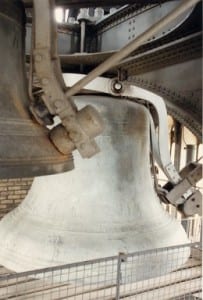After doing extensive research into ‘The Big Ben’ clock tower it has given us more ideas on what to include in our performance. There are many clips of the sound the clock makes every hour which we may use as part of our soundscape throughout the performance, the four quarter bells sound G♯, F♯, E, and B. We could even use an instrument to make this significant sound of maybe bring an actual bell into the gallery to hit.
Also we researched the significance in popular culture that the Big Ben has had, the clock is now a symbol of the United Kingdom and London, especially in visual media and attracts thousands of tourists every month. Even though we live so close to London and have been many times we still visit the Big Ben each time we go to London as it is such an iconic building. When a television or film-maker wants to indicate a generic location in Britain they usually show an image of the tower or involve the tower in some way. On entering every New Year the Big Ben plays a key part and around the country everybody watch’s the fireworks surrounding the clock and relies on the time it shows to celebrate the New Year. Also on Remembrance Day the chimes of the Big Ben are broadcast to mark the 11th hour of the 11th day of the 11th month and the chimes start the two minutes of silence throughout the country. Furthermore on the 27 of July 2012, starting at 8:12 a.m, Big Ben chimed thirty times, to welcome in the London Olympic Games, which officially began that day. In 2008 a survey of 2,000 people found that the tower was the most popular landmark in the United Kingdom. It has also been named as the most iconic film location in London. These facts and examples represent to us how significant The Big Ben is to Britain and how it plays a huge part of the cultured society. By creating our own Big Ben in the gallery there will not be confusion as to what we are creating as everybody around the world is familiar to The Big Ben.
All of these facts help us with our performance as it proves how iconic the Big Ben is and supports our reasoning for using it as the iconic clock. Also we can interpret the facts in the performance and use them, for example we could get newspapers with these facts on them, or even project the facts throughout the gallery for people to read whilst the performance is going in. Finally it has given us a better knowledge on the Big Ben and if we are asked questions during our performance or after from members of the public we can be confident to answer correctly including many facts.
The Big Ben.
The Iconic Bell





 Left: Grandfather clock
Left: Grandfather clock 